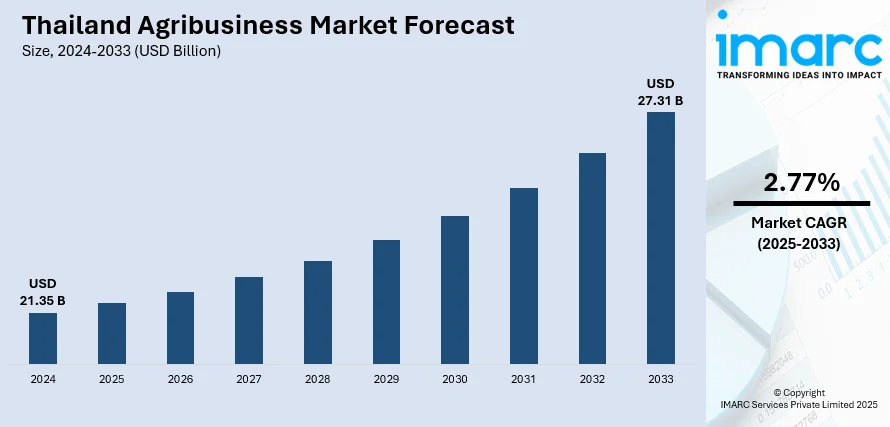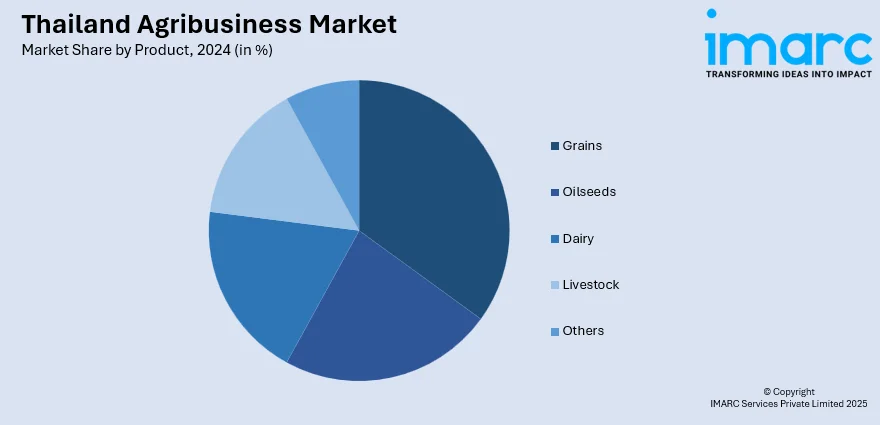
Thailand Agribusiness Market Size, Share, Trends and Forecast by Product and Region, 2025-2033
Thailand Agribusiness Market Overview:
The Thailand agribusiness market size reached USD 21.35 Billion in 2024. The market is projected to reach USD 27.31 Billion by 2033, exhibiting a growth rate (CAGR) of 2.77% during 2025-2033. Modern technologies, including precision farming, automated irrigation systems, and the Internet of Things (IoT)-enabled monitoring devices, are enabling farmers to optimize resource utilization, reduce wastage, and improve crop yields. In addition, the growing exports of agri-food products is contributing to the expansion of the Thailand agribusiness market share.
|
Report Attribute
|
Key Statistics
|
|---|---|
|
Base Year
|
2024
|
|
Forecast Years
|
2025-2033
|
|
Historical Years
|
2019-2024
|
| Market Size in 2024 | USD 21.35 Billion |
| Market Forecast in 2033 | USD 27.31 Billion |
| Market Growth Rate 2025-2033 | 2.77% |
Thailand Agribusiness Market Trends:
Innovations in technology
Technological innovations are essential in impelling the market growth by improving productivity, efficiency, and sustainability throughout the agricultural value chain. Contemporary technologies, including precision agriculture, automated watering solutions, and IoT-connected monitoring tools, allow farmers to enhance resource efficiency, minimize waste, and boost crop production. The adoption of drones for aerial surveying, pest detection, and crop health assessment is further enabling real-time decision-making, minimizing losses and increasing operational efficiency. Advancements in biotechnology like high-yield and pest-resistant crop varieties are helping mitigate challenges related to climate change and soil degradation. Digital tools, including farm management software and mobile applications, provide farmers with weather forecasts, market prices, and best practice guides, improving overall farm planning. Companies are launching smart farming platforms to integrate artificial intelligence (AI), sensors, and big data analytics for real-time farm optimization. In February 2025, the National Electronics and Computer Technology Centre (NECTEC) introduced a new smart farming platform called ‘HandySense B-Farm,’ which utilized smart sensors, AI, and the IoT to aid farmers in effectively managing and controlling their farms. It would allow farmers to leverage digital technology to enhance their skills and foster sustainability in agricultural production, aiding in cost reduction and increasing the competitiveness of the Thai agricultural sector internationally.

To get more information on this market, Request Sample
Increasing exports of agri-food items
Strong exports of agri-food items are propelling the Thailand agribusiness market growth. As reported by the Thai Trade Policy and Strategy Office (TPSO), in 2024, Thailand generated USD 52.19 Billion from exports of agricultural and agro-industrial products, reflecting a 6% rise compared 2023. International buyers value Thailand’s reputation for high-quality, safe, and diverse agricultural products, catalyzing stable demand from regions like the Middle East, Europe, and North America. This sustained demand is encouraging farmers, cooperatives, and agribusiness firms to expand production capacity, adopt modern farming technologies, and implement stringent quality control measures to meet international standards. The growth in exports is also driving investments in processing facilities, cold storage, and packaging innovations to ensure products remain fresh during transport. Government initiatives, such as promoting trade agreements and export subsidies, are further supporting the market expansion. Additionally, Thailand’s competitive pricing, tropical climate, and ability to produce crops year-round provide a strong advantage in meeting global food needs.
Thailand Agribusiness Market Segmentation:
IMARC Group provides an analysis of the key trends in each segment of the market, along with forecasts at the country and regional levels for 2025-2033. Our report has categorized the market based on product.
Product Insights:

- Grains
- Wheat
- Rice
- Coarse Grains – Ragi
- Sorghum
- Millets
- Oilseeds
- Rapeseed
- Sunflower
- Soybean
- Sesamum
- Others
- Dairy
- Liquid Milk
- Milk Powder
- Ghee
- Butter
- Ice-cream
- Cheese
- Others
- Livestock
- Pork
- Poultry
- Beef
- Sheep Meat
- Others
The report has provided a detailed breakup and analysis of the market based on the product. This includes grains (wheat, rice, coarse grains – ragi, sorghum, and millets), oilseeds (rapeseed, sunflower, soybean, sesamum, and others), dairy (liquid milk, milk powder, ghee, butter, ice-cream, cheese, and others), livestock (pork, poultry, beef, and sheep meat), and others.
Regional Insights:
- Bangkok
- Eastern
- Northeastern
- Southern
- Northern
- Others
The report has also provided a comprehensive analysis of all the major regional markets, which include Bangkok, Eastern, Northeastern, Southern, Northern, and others.
Competitive Landscape:
The market research report has also provided a comprehensive analysis of the competitive landscape. Competitive analysis such as market structure, key player positioning, top winning strategies, competitive dashboard, and company evaluation quadrant has been covered in the report. Also, detailed profiles of all major companies have been provided.
Thailand Agribusiness Market News:
- In August 2025, U Power Limited teamed up with Chia Tai Co., Ltd., Thailand’s foremost innovative agriculture firm and ICBC (Thai) Leasing Co., Ltd. to collaboratively develop and market a drone platform aimed at facilitating the use of agricultural drones in Thailand. These sophisticated drones would aid numerous tasks, including crop spraying, seeding/spreading, field evaluation, and aerial surveillance and mapping, focused on enhancing operational efficiency, lowering expenses, and facilitating more accurate, data-informed agricultural methods.
- In April 2024, the National Innovation Agency unveiled the ‘AGROWTH’ platform to enhance Thai agricultural startups through advanced technology. The agency recognized three developing technologies in the agricultural sector: AI, robotics and automation, and biotechnology.
Thailand Agribusiness Market Report Coverage:
| Report Features | Details |
|---|---|
| Base Year of the Analysis | 2024 |
| Historical Period | 2019-2024 |
| Forecast Period | 2025-2033 |
| Units | Billion USD |
| Scope of the Report |
Exploration of Historical Trends and Market Outlook, Industry Catalysts and Challenges, Segment-Wise Historical and Future Market Assessment:
|
| Products Covered |
|
| Regions Covered | Bangkok, Eastern, Northeastern, Southern, Northern, Others |
| Customization Scope | 10% Free Customization |
| Post-Sale Analyst Support | 10-12 Weeks |
| Delivery Format | PDF and Excel through Email (We can also provide the editable version of the report in PPT/Word format on special request) |
Key Questions Answered in This Report:
- How has the Thailand agribusiness market performed so far and how will it perform in the coming years?
- What is the breakup of the Thailand agribusiness market on the basis of product?
- What is the breakup of the Thailand agribusiness market on the basis of region?
- What are the various stages in the value chain of the Thailand agribusiness market?
- What are the key driving factors and challenges in the Thailand agribusiness market?
- What is the structure of the Thailand agribusiness market and who are the key players?
- What is the degree of competition in the Thailand agribusiness market?
Key Benefits for Stakeholders:
- IMARC’s industry report offers a comprehensive quantitative analysis of various market segments, historical and current market trends, market forecasts, and dynamics of the Thailand agribusiness market from 2019-2033.
- The research report provides the latest information on the market drivers, challenges, and opportunities in the Thailand agribusiness market.
- Porter's five forces analysis assist stakeholders in assessing the impact of new entrants, competitive rivalry, supplier power, buyer power, and the threat of substitution. It helps stakeholders to analyze the level of competition within the Thailand agribusiness industry and its attractiveness.
- Competitive landscape allows stakeholders to understand their competitive environment and provides an insight into the current positions of key players in the market.
Need more help?
- Speak to our experienced analysts for insights on the current market scenarios.
- Include additional segments and countries to customize the report as per your requirement.
- Gain an unparalleled competitive advantage in your domain by understanding how to utilize the report and positively impacting your operations and revenue.
- For further assistance, please connect with our analysts.
 Request Customization
Request Customization
 Speak to an Analyst
Speak to an Analyst
 Request Brochure
Request Brochure
 Inquire Before Buying
Inquire Before Buying




.webp)




.webp)












